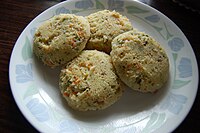
Bombay rava, or ravva, rawa, or sooji, is a durum wheat product and a form of semolina. Rava is made by grinding husked wheat and is used in Indian cuisine to make savoury dishes such as rava dosa, rava idli, upma, and khichdis. There are also sweet dishes made from it, take for example rava ladoo, and sooji halwa in North Indian cuisine which is also known as rava kesari/ kesari bath in South Indian cuisine. [1] [2]
Contents
There is another type of semolina (rava) known as chamba rava, which is a byproduct obtained while milling for wheat flour, Bombay rava is actually made of maida, and hence it is finer. [3]